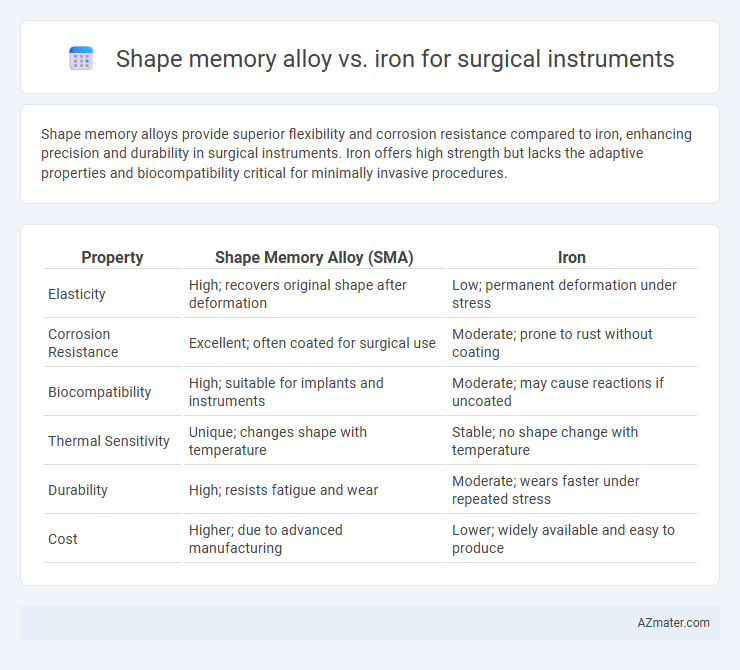Shape memory alloys provide superior flexibility and corrosion resistance compared to iron, enhancing precision and durability in surgical instruments. Iron offers high strength but lacks the adaptive properties and biocompatibility critical for minimally invasive procedures.
Table of Comparison
| Property | Shape Memory Alloy (SMA) | Iron |
|---|---|---|
| Elasticity | High; recovers original shape after deformation | Low; permanent deformation under stress |
| Corrosion Resistance | Excellent; often coated for surgical use | Moderate; prone to rust without coating |
| Biocompatibility | High; suitable for implants and instruments | Moderate; may cause reactions if uncoated |
| Thermal Sensitivity | Unique; changes shape with temperature | Stable; no shape change with temperature |
| Durability | High; resists fatigue and wear | Moderate; wears faster under repeated stress |
| Cost | Higher; due to advanced manufacturing | Lower; widely available and easy to produce |
Introduction to Shape Memory Alloys and Iron in Surgery
Shape memory alloys (SMAs), primarily composed of nickel-titanium (Nitinol), exhibit unique properties such as superelasticity and the ability to return to a pre-defined shape after deformation, making them highly valuable in surgical instruments for minimally invasive procedures and enhanced precision. Iron, traditionally used in surgical tools, provides strength and durability but lacks the flexibility and biocompatibility found in SMAs, limiting its application in advanced surgical techniques. The integration of SMAs in surgical devices improves patient outcomes by enabling innovative designs that adapt dynamically within the human body, contrasting with the rigid nature of iron-based instruments.
Material Properties: Shape Memory Alloys vs Iron
Shape memory alloys (SMAs), such as Nitinol, exhibit exceptional superelasticity and biocompatibility, making them ideal for minimally invasive surgical instruments compared to conventional iron. SMAs offer superior corrosion resistance and the unique ability to return to their original shape after deformation, enhancing precision and durability in surgical applications. In contrast, iron lacks inherent elasticity, is prone to corrosion, and offers lower biocompatibility, limiting its effectiveness for advanced medical tools.
Biocompatibility and Safety in Surgical Applications
Shape memory alloys, such as Nitinol, exhibit superior biocompatibility compared to traditional iron-based surgical instruments due to their corrosion resistance and minimal ion release, reducing the risk of tissue inflammation and allergic reactions. Their unique ability to return to a predetermined shape enhances precision and safety in minimally invasive procedures, while iron instruments may pose greater risks of corrosion and metal ion toxicity. This makes shape memory alloys a preferred choice for durable, safe, and biocompatible surgical tools in advanced medical applications.
Corrosion Resistance and Durability
Shape memory alloys (SMAs) exhibit superior corrosion resistance compared to traditional iron, making them more suitable for surgical instruments exposed to bodily fluids and sterilization processes. Their exceptional durability stems from the ability to undergo repeated deformation and recovery without permanent damage, unlike iron, which is prone to corrosion and mechanical fatigue over time. This combination of corrosion resistance and long-lasting performance ensures SMAs enhance the longevity and reliability of surgical tools in medical applications.
Flexibility and Adaptive Functionality
Shape memory alloys (SMAs) exhibit superior flexibility compared to iron, enabling surgical instruments to bend and return to their original shape without permanent deformation. This adaptive functionality allows SMA-based tools to conform to complex anatomical structures, enhancing precision and reducing tissue damage during procedures. In contrast, iron instruments lack this capability, making them less effective in minimally invasive surgeries that require dynamic maneuverability.
Performance in Minimally Invasive Procedures
Shape memory alloys offer superior flexibility and precise control in minimally invasive surgical instruments compared to traditional iron, enabling enhanced maneuverability in confined anatomical spaces. Their ability to return to a predetermined shape after deformation allows for improved durability and consistent performance during repetitive surgical actions. Iron instruments, while strong, lack the elasticity and corrosion resistance of shape memory alloys, limiting their effectiveness in delicate, precision-demanding procedures.
Manufacturing and Cost Considerations
Shape memory alloys used in surgical instruments, such as Nitinol, require specialized manufacturing processes including precision heat treatment and complex alloy composition control, which increase production costs compared to conventional iron-based instruments. Iron instruments benefit from well-established, cost-effective manufacturing techniques like casting and forging, resulting in lower material and processing expenses. While shape memory alloys offer superior flexibility and corrosion resistance, their higher manufacturing complexity and raw material costs significantly impact overall surgical instrument pricing.
Sterilization and Maintenance Differences
Shape memory alloys (SMAs) offer superior corrosion resistance and can withstand repeated autoclaving without degradation, making them highly suitable for sterilization compared to traditional iron-based surgical instruments, which are prone to rust and require special coatings or frequent maintenance. SMAs maintain dimensional stability and retain mechanical properties after high-temperature sterilization cycles, reducing the risk of contamination and extending instrument lifespan. Iron instruments often demand more rigorous maintenance protocols, including regular cleaning, drying, and protective treatments to prevent oxidation and ensure reliability during surgical procedures.
Clinical Outcomes and Surgeon Preferences
Shape memory alloys (SMAs), such as Nitinol, offer superior flexibility and corrosion resistance compared to traditional iron-based instruments, resulting in enhanced clinical outcomes like reduced tissue trauma and faster patient recovery. Surgeons prefer SMAs for their precise shape retention and improved durability, which allow for more meticulous manipulation during minimally invasive procedures. Iron instruments, while cost-effective and widely available, tend to exhibit higher rates of corrosion and lower biocompatibility, potentially affecting long-term surgical success and surgeon satisfaction.
Future Trends in Surgical Instrument Materials
Shape memory alloys (SMAs) offer superior flexibility and biocompatibility compared to traditional iron-based instruments, enabling minimally invasive surgical techniques and faster patient recovery. Future trends emphasize integrating SMAs with smart technologies for enhanced precision, such as temperature-responsive and self-healing capabilities, which iron lacks. Innovations in nanostructured SMAs are poised to revolutionize surgical tools by providing improved corrosion resistance and adaptability in complex anatomical environments.

Infographic: Shape memory alloy vs Iron for Surgical instrument
 azmater.com
azmater.com